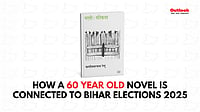Delhi Chief Minister Arvind Kejriwal on Monday launched a study to gather realtime information on sources of pollution and help the government launch a targeted response.
What did Kejriwal say?
He said the reason for pollution changes on an hourly basis and until "we calculate the source of the pollution on a realtime basis, we cannot have an effective policy on the issue".
Kejriwal inaugurated the 'realtime source apportionment supersite' at Rouse Avenue along with an air quality monitoring van.
"Today launched one such van, but once this stabilises and the data from this van comes in, we will launch several other such vans that can provide us data from the different wards of Delhi.
"We will also use these vans to study the source of pollution in hotspot areas and once the data comes in, it will tell us about the main source of pollution and then we will take action on the data.
"There will be a super site on the second floor of this building, there will also be a mobile air quality monitoring system, there is also a forecasting system and a dashboard and a portal to provide this information," he said.
How tracking realtime pollution sources will help?
By getting information about the real-time pollution sources, the government will be able to tackle the problem in a more targeted way, the chief minister added.
"As we have seen here today, the reasons for pollution change on an hourly basis. The major source of pollution at 8 am yesterday was different from that at 9 am.
"Until we calculate the source of the pollution on a real-time basis, we cannot have an effective policy on the issue. We will know the percentage of pollution that is caused due to vehicular movement, garbage burning, industries and so on," he said.
Kejriwal said the system will also forecast major factors of pollution in the coming days. It can forecast on an hourly basis for the next three days.
Explaining further, he said the system will also provide information on how much pollution is generated in Delhi and how much comes from outside Delhi.
"The data shows us that biomass burning was high during the last three months from November. This is basically the pollution caused by people burning wood and other biomass to keep themselves warm," he said.
Watchmen and security guards light fires to keep themselves warm, which leads to a temperature inversion. All this pollution then remains in the air, Kejriwal said.
"This forms as much as one-fourth or one-fifth of the total pollution during this time," he said.
The data also shows that vehicular pollution contributes around 17-18 per cent of the total pollution and this is constant through winters.
He cited how steps to tackle pollution were based on years-old studies and stressed it has always been difficult for any organisation or state government to analyse and verify the data related to air pollution.
All about the venture and its development
The real-time source apportionment study is a joint venture between Delhi Pollution Control Committee (DPCC), IIT-Delhi, IIT-Kanpur and TERI.
The DPCC is the owner agency, IIT-Kanpur is in-charge of lead measurement of data, IIT-Delhi is in-charge of forecast and TERI provides the emission inventory.
"This team had been working on this model over the last 1-1.5 years. The Delhi government had been working on such a model for the last three years. We also contacted some institutions in Washington for this project, but those attempts did not materialise. This system will assist us in taking micro-level steps to curb pollution in Delhi," Kejriwal said.
The AAP government has taken several steps to reduce pollution in the national capital. Whenever the need arises, the Graded Rapid Action Plan (GRAP) is implemented in Delhi, he said.
"The cumulative effect of all this is that the average annual pollution of Delhi in the last five years has been the lowest," he said.
Despite these efforts, the problem persists, he said.
The recent announcement of mechanised sweeping of roads and footpaths will play a major role in combating pollution, he said.
Environment Minister Gopal Rai said that based on the pollution data, they will be able discuss to with the governments of neighbouring states and plan pollution control measures accordingly.
(With PTI Inputs)

























